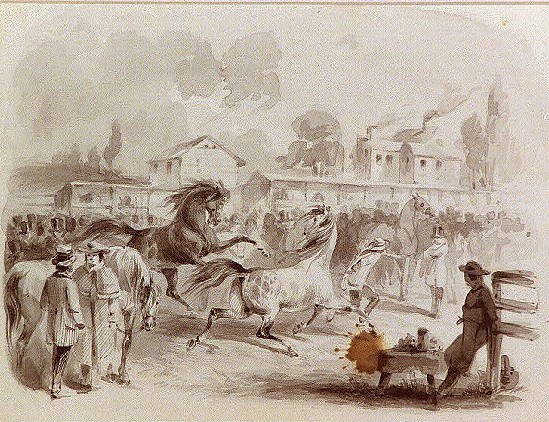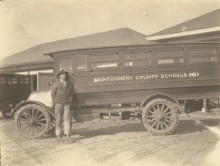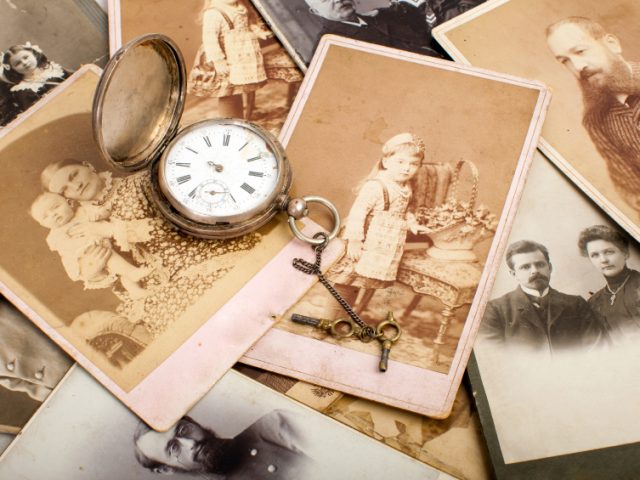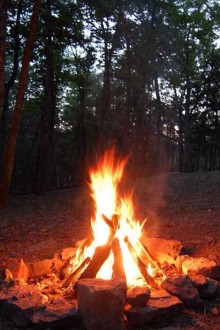This story is available for FREE! See how to Become a Patron and read all of lost and forgotten Alabama stories.Become an Alabama PIONEERS Patronfor only $2 per month. Cancel anytime
The spirit of the old Trojans had become quite prevalent, and the rougher element from the outlying districts made a practice of coming to town and running horse races up and down what is now the Main street of Greensboro. In addition to the enactment of the ordinance prohibiting this conduct, several of the prominent gentlemen of the town banded together, and informed the “sports” that they must discontinue their practice; in fact, our notes recite that the aforesaid gentlemen made their lecture to the lawless element more forcible by having their pistols with them, and informing the offenders that if they were guilty of running races on the Main street again they would be shot from their horses. This had the desired effect, and the “jockeys,” in the after years— 1834—made another track two miles west of town near the plantation known as the Jenkins place, and kept up the sport for a number of years.
Horse Racing
(Excerpt below was published in 1908)
Among the first ordinances passed by the Intendant and Council of Greensboro, Alabama was one to prohibit horseracing through the Main street.
The spirit of the old Trojans had become quite prevalent, and the rougher element from the outlying districts made a practice of coming to town and running horse races up and down what is now the Main street of Greensboro. In addition to the enactment of the ordinance prohibiting this conduct, several of the prominent gentlemen of the town banded together, and informed the “sports” that they must discontinue their practice; in fact, our notes recite that the aforesaid gentlemen made their lecture to the lawless element more forcible by having their pistols with them, and informing the offenders that if they were guilty of running races on the Main street again they would be shot from their horses. This had the desired effect, and the “jockeys,” in the after years— 1834—made another track two miles west of town near the plantation known as the Jenkins place, and kept up the sport for a number of years.
 Horses at auction or races painting ca. 1840 Felix Octavius Carr Darley, 1822-1888, artist (Library of Congress)
Horses at auction or races painting ca. 1840 Felix Octavius Carr Darley, 1822-1888, artist (Library of Congress)
It finally fell into disuse in this section (of Alabama) altogether, and there has not been a horse race in Greensboro for many, many years.
But to go back a little: A note before us says that on an extra gala occasion in Greensboro in the days of the reign of the “jockeys,” that as a bunch of the racers came dashing up the street at breakneck speed, one of the horses flew the track and ran into a dogwood thicket where the old Whelan residence (now owned by Mrs. Ricard) stands and killed the jockey. The name of the unfortunate fellow is forgotten, and even the place of his burial was not remembered by our informant.
During the period between 1823 and 1832, the citizens of Greensboro seem to have allowed their charter to lapse from non-use, for on January 21, 1832, the Legislature passed an Act “To revive, repeal in part and amend an An act to Incorporate the Town of Greensborough in the county of Greene, approved December 24, 1823.” By this Act, the following taxes only could be assessed and collected: 1. Not exceeding one-fourth of one per cent on real property. 2. A poll tax of $1 on each white male inhabitant over the age of twenty-one years. 3. Not exceeding $1 each on all four-wheeled pleasure carriages. 4. On all retailers of liquors, goods, and merchandise, not exceeding $10 per annum. From the foregoing, it will be seen that the income of the town was quite small, but the expenses were equally so.
The officers received no salaries. The Intendant was allowed to charge only a small fee for the trial of criminal offences, and the Constable was also allowed to charge a nominal fee for making arrests, but it was a rare occurrence for a case to be reported to the Intendant. Nearly all the cases for breach of peace, if reported at all, were carried before the Justices of the Peace, whose courts were kept quite busy at times—and all were white people who were tried, as the negroes were slaves, and were rarely ever guilty of violating the laws either of the town or the State.
The corporate limits of the town at this time were the quarter section—160 acres—and so remained until January 12, 1833, when they were extended to embrace the residence and lots now owned and occupied by Charles E. Latimer. The object of the extension was to relieve the owner—John Marast—of the duty of working the public road outside of the town.
SOURCE
Excerpt transcribed from HISTORY OF GREENSBORO, ALABAMA From Its Earliest Settlement by William Edward Wadsworth Yerby, Montgomery, Alabama, The Paragon Press, 1908 transcribed by Debra Hudson
ALABAMA FOOTPRINTS- Pioneers – A Collection of Lost and Forgotten Stories
Stories include:
- The Yazoo land fraud;
- Daily life as an Alabama pioneer;
- The capture and arrest of Vice-president AaronBurr;
- The early life of William Barrett Travis in Alabama, hero of the Alamo;
- Description of Native Americans of early Alabama including the visit by Tecumseh;
- Treaties and building the first roads in Alabama.





Odette Yeager
Our church is actually built on property where a gambling house once stood!